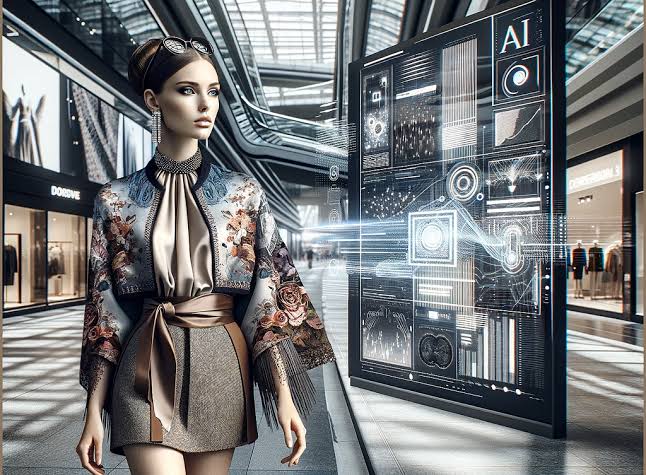Explore how AI-generated fashion is transforming the industry by redefining style and aesthetics. Discover how AI enhances fashion design, predicts trends, personalizes shopping experiences, and optimizes manufacturing. Learn about the potential impact on sustainability and ethical considerations as AI reshapes the future of fashion.
Fashion, Revolutionized AI in Redefining Trends and Visual Appeal.
Introduction
The blending of intelligence (AI) with the fashion world is bringing about changes. Whether it's crafting one of a kind garments forecasting upcoming styles or tailoring shopping experiences AI is revolutionizing the way fashion is designed, enjoyed and perceived. This piece explores the ways in which AI driven fashion is reshaping trends and beauty standards focusing on its influence in design, manufacturing and customer interaction.
The Role of AI in Fashion Design
The role of AI, in fashion design is a groundbreaking advancement that fuses creativity with insights driven by data. AI algorithms have the ability to analyze data including past fashion trends, consumer preferences and current market needs to come up with fresh design concepts. By processing this information AI can produce designs that are not innovative but also in tune with fashion trends.
One of the most exciting applications of AI in fashion is generative design. This involves algorithms creating design variations based on specified parameters. Designers can harness AI to explore new visual possibilities, experiment with fabric combinations and play around with patterns and silhouettes. This method opens the door to styles and can result in the development of highly unique and customized clothing pieces.
Predicting Fashion Trends with AI
AI's ability to analyze and understand data makes it a valuable asset, for predicting fashion trends. Machine learning algorithms can comb through media posts, fashion websites and online shopping data to spot trends and consumer preferences. By identifying patterns and connections AI can accurately predict upcoming fashion styles.
This forecasting capability is advantageous for designers and retailers as it offers insights, into which styles, colors and materials are likely to gain popularity in the future. It enables fashion brands to make informed choices about their product lines reducing the chance of creating items that may not appeal to consumers. Moreover AI powered trend analysis helps brands stay competitive by quickly adapting to changing consumer preferences.
Personalizing the Fashion Experience
The use of AI technology is revolutionizing how fashion brands tailor their offerings to customers. By examining peoples preferences, shopping habits and previous purchases AI can suggest clothing options that match their style. These personalized recommendations not enhance the shopping experience. Also boost customer satisfaction and loyalty.
Another innovation in the fashion industry is the introduction of fitting rooms, powered by AI. These tools allow shoppers to virtually try on outfits using reality (AR) or 3D modeling. By uploading a photo or utilizing a webcam customers can see how different clothes will fit them without needing to physically try them on. This technology not decreases return rates. Also assists customers in making informed buying choices.
AI is also being used to streamline manufacturing processes and optimize supply chains in the fashion industry.
The fashion industry is undergoing a transformation thanks to AI's impact on manufacturing and supply chain management. In the production process AI algorithms can boost efficiency by predicting equipment issues, managing inventory and optimizing logistics. For instance AI can anticipate demand for products enabling manufacturers to adjust their production timelines and minimize waste.
AI is also making strides in enhancing supply chain efficiency. By analyzing data from sources such as suppliers, transportation systems and inventory levels AI can pinpoint areas of improvement and suggest solutions. This results in streamlined and cost effective supply chain operations, ensuring timely delivery of products to retailers and consumers.
Ethical Considerations and Sustainability
As artificial intelligence (AI) becomes integrated, into the industry discussions around ethics and sustainability are gaining traction. AI powered fashion has the potential to tackle environmental issues linked to traditional fashion manufacturing processes. For instance AI can help minimize waste by streamlining production methods and accurately forecasting demand.
However there are concerns about AI's impact on employment, within the fashion sector. The automation of design and production processes may displace jobs. To address these concerns it's crucial for the industry to prioritize retraining and upskilling workers to adapt to the changing technological landscape.
Additionally the use of AI in fashion raises issues, regarding privacy and security. With AI systems collecting and analyzing data it's essential to handle this information responsibly and in accordance with privacy regulations.
The Future of AI-Generated Fashion
The potential future of fashion, powered by AI looks promising. With ongoing advancements in technology we can anticipate advanced design tools, trend forecasting models and tailored shopping experiences. The collaboration of AI with emerging innovations like blockchain and 5G will further boost the fashion sectors capabilities.
AI in fashion has the ability to democratize the design process making it available to a wider audience and encouraging increased creativity. Additionally it presents opportunities for customization enabling consumers to craft clothing pieces that showcase their individual style.
Conclusion
The emergence of fashion is revolutionizing the look and feel of the industry by blending imagination with data based insights. Whether it's through design methods, forecasting trends or tailoring shopping experiences AI is reshaping the way we produce and enjoy fashion. Although there are ethical dilemmas and hurdles to overcome the incorporation of AI into fashion presents prospects for what lies ahead. With advancements AI is set to play a role in influencing the fashion landscape making it more vibrant, customized and eco friendly.
